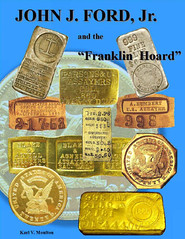
About UsThe Numismatic Bibliomania Society is a non-profit organization promoting numismatic literature. For more information please see our web site at coinbooks.org SubscriptionsThose wishing to become new E-Sylum subscribers (or wishing to Unsubscribe) can go to the following web page link MembershipThere is a membership application available on the web site Membership Application To join, print the application and return it with your check to the address printed on the application. Membership is only $15 to addresses in the U.S., $20 for First Class mail, and $25 elsewhere. For those without web access, write to: David M. Sundman, Secretary/TreasurerNumismatic Bibliomania
Society AsylumFor Asylum mailing address changes and other membership questions, contact David at this email address: dsundman@LittletonCoin.com SubmissionsTo submit items for publication in The E-Sylum, just Reply to this message, or write to the Editor at this address: whomren@coinlibrary.com
BUY THE BOOK BEFORE THE COINYou won't regret it! |
- WAYNE'S WORDS: THE E-SYLUM JULY 17, 2011
- LAKE BOOKS MAIL BID SALE #108 PRICES REALIZED LIST AVAILABLE
- KARL MOULTON'S SPRING/FALL 2011 FIXED PRICE LIST
- NEW BOOK: JOHN J. FORD, JR. AND THE "FRANKLIN HOARD"
- NEW BOOK: CHARBNEAU SO-CALLED DOLLARS
- NEW BOOK: LE ZECCHE ITALIANE FINO ALL'UNITÀ
- BOOK REVIEW: COLLECTING RARE COINS FOR PLEASURE AND PROFIT
- A FEW REMEMBRANCES OF CHARLES MCSORLEY
- 2011 CHICAGO ANA NUMISMATIC THEATRE SCHEDULE ANNOUNCED
- MORE ON THE U.S. MINT CAPT. BIDDLE MEDAL
- QUERY: INGLE SYSTEM SCRIP LEDGERS AND VIRGINIA TOKEN BOOKS
- NOTES FROM E-SYLUM READERS: JULY 17, 2011
- WAYNE'S NUMISMATIC DIARY: JULY 17, 2011
- COUNTERSTAMP RESEARCH: THE HALLMARKS OF THEOPHILUS BRADBURY
- OSTHEIMER COLLECTION RARITIES SALE PART III
- "TIME CAPSULE" SNELL COLLECTION OF CHINESE COINS OFFERED
- NEW PARIS MINT COMMEMORATIVE COINS SIMULATE HAMMERED STRIKING
- THE MAN WHO LOVED PRESIDENTIAL MEMORABILIA TOO MUCH?
- TURNING DOLLAR COINS INTO FREE TRAVEL
- CAPTAIN BLIGH'S MEDALS TO BE SOLD
- S. KOENIGSBERGER GOLD BAR SURFACES
- NUMISMATIC SIGNIFICANCE OF THE SREE PADMANABHASWAMY TEMPLE TREASURE
- OPERATION BERNHARD COUNTERFEIT NOTES RECOVERED FROM LAKE TOPLITZ TO BE SOLD
- URSULA KAMPMANN'S GREEK NUMISMATIC DIARY: EDESSA
- QUERY: CARPATHIA CAPTAIN'S CONGRESSIONAL GOLD MEDAL INFORMATION SOUGHT
- ARTICLE ON COINS IN KENYA
- A BIBLIOPHILE'S NIGHTMARE: BAGHDAD'S JEWISH ARCHIVE
- A NEW JERSEY DINER'S LUCKY DOLLARS
- FEATURED WEB SITE: THE CANADIAN NUMISMATIC PUBLISHING INSTITUTE
WAYNE'S WORDS: THE E-SYLUM JULY 17, 2011

Among our new subscribers this week are Gary Braisted, Robert (BJ) Neff, Joel Reznick, Robert Russell and Sam Gelberd, all courtesy of John and Nancy Wilson, and Richard DeNise, M.D, Welcome aboard!
We have 1,437 email subscribers, plus 152 followers on Facebook, including Kenny Meredith and Daniel Dan.
First, a correction. Thanks to Joe Boling for noting that I inserted a superfluous "e" in the last name of James Charlton in last week's issue. Sorry! We'll correct the E-Sylum online archive.
Now, a clarification. The item in last week's "Notes from E-Sylum Readers" section headlined "E-Books Ruined My Love Life" was referred to us by Kay O. Freeman, but wasn't written by her. The link is to the original article on a New York Times blog page.
This week we open with updates from literature dealers Fred Lake and Karl Moulton, announcements of three new numismatic books, and a review of a fourth. Other topics this week include Ingle system script, the Snell collection of Chinese coins, and a previously unknown Western gold bar.
To learn more about Theophilus Bradbury, machine-made coins that imitate the look of hammered coins, and the medals of Captain Bligh, read on. Have a great week, everyone!
Wayne Homren
Numismatic Bibliomania Society
LAKE BOOKS MAIL BID SALE #108 PRICES REALIZED LIST AVAILABLE
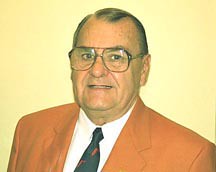 The prices realized list for our mail-bid sale #108 of numismatic literature is now available for viewing on our web site at
http://www.lakebooks.com/current.html
.
The prices realized list for our mail-bid sale #108 of numismatic literature is now available for viewing on our web site at
http://www.lakebooks.com/current.html
.
The sale featured selections from the library of Lucien "Lou" Philippon and results were strong in early copper-related literature.
Many thanks to all of our bidders and we will be shipping lots won over the next two weeks with invoices to follow shipment.
Our next sale will be held in October, 2011.
Lake Books
6822 22nd Ave. N.
St. Petersburg, FL 33710
727-343-8055 Fax 727-345-3750
KARL MOULTON'S SPRING/FALL 2011 FIXED PRICE LIST
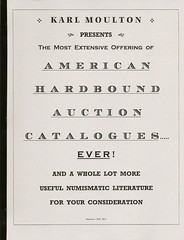 Karl Moulton's Spring/Fall 2011 fixed Price List of numismatic literature has been published.
Highlighted is "The most extensive offering of American hardbound auction catalogues ... Ever!"
A printed version is available for $5.
Karl Moulton's Spring/Fall 2011 fixed Price List of numismatic literature has been published.
Highlighted is "The most extensive offering of American hardbound auction catalogues ... Ever!"
A printed version is available for $5.
The inside back cover has an announcement offering his upcoming book, John J. Ford Jr. and the "Franklin Hoard".
See the next article in this issue for more information.
NEW BOOK: JOHN J. FORD, JR. AND THE "FRANKLIN HOARD"
- A comprehensive background on Western gold items and gold rushes
- The Father Kino "Silver Trade Bar" story
- An extensive accounting of bars and ingots known before 1950
- Hundreds of John J. Ford's personal letters and invoices from the 1950s and 1960s
- The names of assayers that were in contact with Gerow Paul Franklin, the "Hoard's" namesake, along with sources in Phoenix and elsewhere
- The "Franklin Hoard" material will be listed for the first time
- Images of previously unknown gold and silver bars and coins that make up the "Franklin Hoard", most are in color
- The 1966-1968 P.N.G. arbitration proceedings on counterfeit $20 U.S.A.O.G. coins
- Walter Breen & Don Taxay's involvement
- The Josiah K. Lilly gold collection "donated" to the Smithsonian Institution
- The J.K. Llly appraisal -- first time ever in print
- Background on gold bars including Parsons, Weigand, Kohler, Eagle, Thorne, Star, FG Hoard, Knight & Co., along with the so-called S.S. Brother Jonathan bars
- The "Great Debate" of 1999 between Michael Hodder and Ted Buttrey
Counterfeits were made. Were Ford and Franklin forgers? Find the answer and more in John J. Ford and the "Franklin Hoard". The 700 page book will ship around the end of the year. Limited to 250 copies.
Pre-Publication Price $250
Regular Price after October 15, $295
Tom DeLorey writes:
I look forward to hearing Karl Moulton's talk at the ANA, based, in part, upon the letters of John J. Ford.
I once saw an interesting letter written by Ford to the Editor of The Numismatic Scrapbook Magazine circa late 1974. Apparently some article in Scrapbook had questioned the validity of a number of territorial gold issues that had been discovered or revealed by Ford in the late 1950s and/or early 1960s, which had been listed in the Redbook for a few years, only to disappear from the Redbook en masse circa 1964.
The Letter to the Editor claimed that the questionable items had been "removed from the Redbook due to lack of space." I do not know if the Letter was ever published. I do know that Ken Bressett has informed me that Ford's claim was not true.
NEW BOOK: CHARBNEAU SO-CALLED DOLLARS
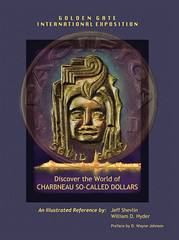 Shevlin and his co-author, William D. Hyder, examine the history, art, and architecture of the Golden Gate International Exposition that inspired Jules Charbneauâs design for his souvenir gold dollars. They tell Jules Charbneauâs life story as well to help the collector better understand the man behind the popular medals, and they uncover his earlier entry into numismatic history when he designed the popular Alaska Gold souvenir medals struck for the Alaska-Yukon-Pacific Exposition in 1909.
Shevlin and his co-author, William D. Hyder, examine the history, art, and architecture of the Golden Gate International Exposition that inspired Jules Charbneauâs design for his souvenir gold dollars. They tell Jules Charbneauâs life story as well to help the collector better understand the man behind the popular medals, and they uncover his earlier entry into numismatic history when he designed the popular Alaska Gold souvenir medals struck for the Alaska-Yukon-Pacific Exposition in 1909.
The heart of the book is Shevlinâs in-depth analysis of the thirteen known varieties of the Charbneau dollar, each personally examined and verified by the senior author. Each variety is illustrated with exceptionally detailed photographs produced by numismatic photographer, Todd Pollack. The images, enlarged 14 times the 12mm diameter of the actual medals, allow the reader the opportunity to fully appreciate the elegance of the design and the artistry of the engraver.
Their story ends by placing the Charbneau so-called dollar within the tradition of small gold exposition souvenirs struck for Farran Zerbe and others in the early 1900s. Although they could not legally be called coins, it is clear that those who issued them marketed them as if they were coins.
Medal specialist, D. Wayne Johnson, says in his Preface for the book, âThis is a delightful story about the artist, the event, and the highly collectible little numismatic items. Call them dollars, or call them medals, you are extremely fortunate if you own even one of Charbneauâs creations.â
Shevlin and Hyder will be at the ANA Library table at the ANA Worldâs Fair of Money in Chicago from 2 to 3 on the afternoon of August 19 to sign copies of their book. They will also deliver a Numismatic Theater presentation earlier that same morning.
The book can be ordered from So-Called Books, 7737 Fair Oaks Blvd., Suite 250, Carmichael, California 95608. Hardbound, 8 ½ x 11, 94 page, full color editions are $34.95. A signed and numbered collectorâs leather bound edition, limited to 75 copies, is available for $95. Shipping is $4.50 per book. California orders must add 9.25% sales tax.
For more information visit online at www.So-CalledDollar.com, telephone the firm at (916) 955-2569 or email the business at SoCalledGuy@Hotmail.com.
NEW BOOK: LE ZECCHE ITALIANE FINO ALL'UNITÀ
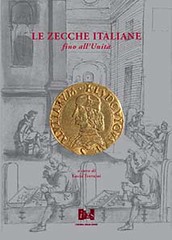 Le Zecche Italiane fino all'Unità edited by Lucia Travaini puts together the documentation related to all Italian mints active from the fifth century AD to the Unification of Italy in 1861. For the first time all this material is collected in one work, offering a comparative and historical view of the activity of such mints.
Le Zecche Italiane fino all'Unità edited by Lucia Travaini puts together the documentation related to all Italian mints active from the fifth century AD to the Unification of Italy in 1861. For the first time all this material is collected in one work, offering a comparative and historical view of the activity of such mints.
It is an impressing quantity of material coming from very different sources and provenances, often from publications difficult to trace and even in languages not easily accessible (such as Russian for the mints on the Black Sea).
This book will be a unique tool for a better classification of all Italian coins: previous catalogues such as the Corpus Nummorum Italicorum are updated in this book with full explanations and discussion of new attributions and chronologies. There are no similar works for other countries in Europe.
The first part of the book consists of introductory essays dealing with the historiography of Italian mints, mint technology and organization, medieval and modern minting right, mining and mint relations, metrology and monetary weights; there are also general overview on early medieval, Byzantine and Carolingian mints.
Mintsâ entries are organized alphabetically in four sections: mints in todayâs Italy; mints abroad active for some Italian State authority, such as Avignon, Caffa, Chios; mints active during a siege; forgersâ or non official mints. Each mint entry consists of: a historical profile; list of all coins struck (no illustration is given but problem-coins are discussed with full bibliography); list of main collections where coins are kept; description of mint building and location; list of mint personnel, mint equipment, archival sources and full bibliography (from Muratori 1739 to 2008/2009). Many entries are also dedicated to mints which never really existed but which had been âcreatedâ for local pride or wrong attributions of coins or documents.
Over sixty authors contributed to writing essays and mint entries: Italian and international university lecturers, museum curators, archivists, independent scholars. The editor of the book is Associate Professor at the Università Statale di Milano, Dipartimento di Scienze dell' Antichità (since 1998); she is co-author with Philip Grierson of Medieval European Coinage volume 14 (South Italy, Sicily and Sardinia), and author of many books and articles.
The full summary of the book and list of names of all authors can be downloaded from the homepage of Lucia Travaini (www.luciatravaini.it).
To read the complete article, see: Important book on the Italian mints (www.coinsweekly.com/en/News/4?&id=689)
BOOK REVIEW: COLLECTING RARE COINS FOR PLEASURE AND PROFIT
Collecting Rare Coins For Pleasure And Profit â" An Insiderâs Guide To Todayâs Market, By Q. David Bowers, Foreword By Kenneth Bressett, Whitman Publishing, LLC, 2011, Reviewed By John and Nancy Wilson
 The latest book by Q. David Bowers on Collecting Rare Coins - For Pleasure And Profit, with a Foreword by Kenneth Bressett, is filled with useful information which will help anyone to start collecting or investing in coins. The softcover reference has 138 pages and contains many well done color illustrations of coins, publications and other interesting subjects. We feel Mr. Bowers is one of the greatest numismatists who has ever lived.
The latest book by Q. David Bowers on Collecting Rare Coins - For Pleasure And Profit, with a Foreword by Kenneth Bressett, is filled with useful information which will help anyone to start collecting or investing in coins. The softcover reference has 138 pages and contains many well done color illustrations of coins, publications and other interesting subjects. We feel Mr. Bowers is one of the greatest numismatists who has ever lived.
The Foreword by Ken Bressett contains some important information. Quoting two things from the Foreword that we particularly liked. Quoting, âWill simply reading this text automatically make you an expert ready to avoid pitfalls, false starts, or adverse purchases? Of course not. It will put you on track, however, and point you in the right direction.â The six tips by Mr. Bressett were all excellent and gave terrific information. We especially like No. 5, âBuy the best coins you can afford, but be cautious of coins that may be overpriced because of âgrade rarityâ or market hype.â We have always bought the best condition item we could afford. Over the years, the high grade items we purchased have soared in price more than lower grade items we could have bought.
The ten Chapters that follow start out with, âWelcome to Coin Collecting.â It includes, âThere is no substitute for knowledge when you buy coins.â Early on in our collecting, we always followed Aaron Feldmanâs quote - buy the book before the coin.
The Second Chapter gives you information on âEarly Popularity of Rare Coins.â You learn that before 1800 there was little activity in numismatics and only a few dozen people were active in the hobby. The information on some of the early collectors is fascinating reading. You will also learn who the first professional numismatist in the United States was. This chapter also covers âThe Mint Cabinetâ which opened at the Philadelphia Mint in 1838. âThe Excitement of 1857,â will explain the Act of February 21, 1857 which abolished the copper half cent and cent. Another important part in this chapter is the formation of âThe American Numismatic Society (ANS)â in 1858, by teenager Augustus B. Sage. âThe Market Expandsâ gives you information on Philadelphia dealer William K. Idler.
Another important person who is covered is Mint Director James Ross Snowden. Mr. Bowers covers nicely the importance of Mr. Snowden and his issuance of many pattern coins that are avidly sought today. âThe American Civil Warâ lets you know how our coinage was hoarded and other coins of necessity made their appearance. These coins of necessity from the Civil War are numismatic items we avidly have collected for many years. âThe American Journal Of Numismaticsâ was the first regularly issued coin magazine which started in 1866. âThe Incredible 1880sâ covers the great expansion of coin dealers and auction houses and closes out with âCoin Collecting In The 1890s.â The American Numismatic Association (ANA) is also covered and was formed in 1891.
Chapter Three covers âThe 20th-Century Coin Market.â According to the book, as this century was entered, we find that privately issued tokens, colonial coins, and encased postage had become very popular and not many collectors collected varieties or branch mint coins from any U. S. coin series. In 1907 the High Relief gold double eagle was minted and is very interesting reading. The âUnbelievable Depression Yearsâ gives some insight into President Rooseveltâs order in 1933 for citizens to turn in their gold coins. The 1930s also saw J. K. Post issue the first penny boards, and B. Max Mehl heavily advertise his âStar Rare Coin Encyclopedia.â
The âWartime Years And Later,â lead to âA Guide Book of United States Coinsâ in 1946 which is published by Whitman Publishing Co. âGrading By The Numbersâ is every important and covers Dr. William H. Sheldon and his Early American Cents reference and grading standards. The âExciting 1950sâ saw the 1950-D low-mintage nickel make its appearance and how quickly it accelerated in price. Chet Krauseâs Numismatic News made its appearance in 1952. The Professional Numismatists Guild (PNG) was formed in 1955.
Chapter Four covers âThe Coin Market Becomes Dynamic.â Coin World (Amos Press) made its appearance in 1960. The early 1960s saw teletype circuits linking dealers and the Coin Dealer Newsletter make their appearance. Several national coin clubs made their appearance in the early 1960s. It was interesting reading that the coin-investment market came to a halt around 1965. It was also at this time that the areas which did not participate in the investment boom started to move upward. âANACS Grades Coinsâ brought back memories as Nancy was on the Board when it was sold by ANA to Amos Press.
âExcitement In The Late 1970sâ explains how the Hunt brothers ran up the price of silver; the sale of some important collections; and how in 1979 coin investment was one of the hottest things going. âGrading Becomes More Importantâ saw David Hall start a grading service, PCGS, and John Albanese establish NGC. âThe 1990sâ cover the importance of the Internet, the market improvement for high grade coins, specialty coin clubs and their importance, grading services behavior, registry sets and much more. This chapter also covers the economic downturn starting in 2007 and how it affected the market place for coins.
Chapter Five âGrade and Its Effect on Priceâ lets you become a smart buyer. âThe Importance Of Gradingâ will let you know just how important grading is when buying or selling coins.
Chapter Six âNumerical Grading 1 to 70â covers coins in AG-3 to MS-70. âThird-Party Grading Servicesâ covers only PCGS and NGC as the market leaders with perhaps ANACS as a distant third. âGrading Extras And Frillsâ will let you know about services such as Collectors Acceptance Corporation.
Chapter Seven âHow to Be a Smart Buyerâ gives the information which will help you make wise and sound decisions when buying coins. The four steps are: finding a coin, judging eye appeal, evaluating sharpness and establishing fair market prices. By learning these four, you will have the basics needed to make sound decisions when buying or selling coins.
Chapter Eight âStarting a Fine Collectionâ covers many aspects of collecting, and we like and quote, âI recommend that you collect what you like, not what someone else recommends.â This chapter also covers âFocus On The Optimal Collecting Gradeâ and will give you instructions for getting good value for the money you spend.
Chapter Nine âGreat Collectors and Collections of the Pastâ reminisces on some of the luminaries who contributed greatly to our hobby of today.
Chapter Ten âQuestions and Answersâ covers questions such as: What makes a coin valuable? When is the best time to buy? From whom should I buy coins? And how long should I hold my coins? Some excellent answers are given to important questions everyone has regarding buying and selling coins.
These ten chapters cover very nicely the people, places and things of the numismatic hobby from its early days to the present. It is hard to believe that the author put so much pertinent information on the topic of numismatics in only 138 pages.
Q. David Bowers has brought his lifelong experience, expertise and enthusiasm to a reference that will help when you are buying or selling coins. Even though we have been collectors for over 40 years, this book had some very useful information that we havenât seen before. We highly recommend it to beginning as well as advanced collectors and dealers. This would also be a great gift for a relative or friend. It might possibly get them interested in the hobby. It is available for $9.95 from, Whitman Publishing, LLC, 3103 Clairmont Road, Suite B, Atlanta, GA 30329 or phone (800) 546-2995 or visit their web page at, www.whitmanbooks.com
Actually, now that I think of it, I DID have such an introduction - provided by Dave himself in one of his first books, Coins and Collectors. That one is also on my list of best books for hobby newcomers. This new title brings the introduction up to date, but in a more compact package, perhaps more accessible to today's readers. -Editor
THE BOOK BAZARRE
A FEW REMEMBRANCES OF CHARLES MCSORLEY
I was saddened to learn of Charles H. McSorley's death this week. He was a medal dealer of rare knowledge. His specialty was American political and campaign medals of which he built an extensive collection. The collection was sold at auction by Joseph Levine in two Presidential Coin & Antique sales, November 15, 1997 and July 10, 1998.
Isn't it is interesting to note that medal dealers -- who should be intense competitors -- often become great good friends. Charley was a good friend to all medal dealers, myself included.
Charley became so familiar with the artists of political medals he could often identify the engraver of unsigned pieces. For example, he attributed nine such pieces to engraver James Bale (active 1824-1851). Q. David Bowers assigned two others to this same artist. These were all typographic pieces (without pictorial devices). These attributions were later verified by Wesley Cox, who made a study of diesinkers' letter punches and their diagnostic shapes (and reported by Russell Rulau).
Charley did all the coin shows in the New York City area and one in Pennsylvania where a relative lived. But the number he attended dwindled in the early 1990s as his health declined.
He would occasionally give a talk on political tokens and medals at coin clubs, but never published anything on them. However, in 1985 he had completed a manuscript on all the engravers of political medals that he shared with me. It was so insightful on these engravers, their work, and his opinion of their ability that I cited many of his statements in biographies of these artists in my Databank of American Artists. I was privileged he shared his analysis and comments with me.
I remember one New York City coin show that was so boring we left it one evening to attend a movie together. All my memories of Charlie McSorley are pleasant. I will long remember his smiling presence at coin shows and his willingness to share his rare knowledge of his favorite topic of political medals..
2011 CHICAGO ANA NUMISMATIC THEATRE SCHEDULE ANNOUNCED

Numismatic Theatre, a popular feature of the American Numismatic Associationâs convention education programs, has been finalized for the 2011 ANA Chicago Worldâs Fair of Money, Aug. 16-20. Numismatic Theatre consists of 30-40 minute presentations given by ANA members on a wide range of topics. Presentations will be held Aug. 16-17 and Aug. 19-20 in Room 3 of the Donald E. Stephens Convention Center.
Tuesday, August 16
3 p.m.
Early American Phantasms of C. Wyllys Betts
Robert W. Hoge
Wednesday, August 17
9 a.m.
Fifty Years of Numismatic Research or How to Learn and Earn with Coins
P. Scott Rubin
2 p.m.
Secret History of the First U.S. Mint
Leonard Augsburger and Joel Orosz
Friday, August 19
10 a.m.
How to Succeed in Numismatic Publishing (By Really Trying)
Dennis Tucker
1 p.m.
Fifty Years in the Making: A Guide Book of Mexican Numismatics
Don Bailey and Dennis Tucker
Saturday, August 20
10 a.m.
The S.S. Central America Treasure: Insights and Latest Research
Bob Evans
Also, there is a talk at 9am Friday on A Medal for Fort Dearborn: First Star of the Chicago City Flag by Jamie Franki, designer of the convention medal. Here's the obverse image. Nice!

For more information, see: www.worldsfairofmoney.com
MORE ON THE U.S. MINT CAPT. BIDDLE MEDAL
Dick Johnson writes:
I too, would like a precise date in which the U.S. Mint closed out all back issues of 19th century List Medals.
In the 1980s Mint Director Donna Pope ordered certain remaining list medals packaged as Grab Bags -- three or four to a bag and sold these at slightly reduced prices below the then list prices for these medals. I bought half a dozen of these bags and opened all but two I believe, placing these in my stock of List Medals for sale. I still have one or two bags unopened as evidence of the Mint's arbitrary action.
Obviously the remainders were in uneven quantities. These were of the lesser popular medals. I presume the Washington and Lincoln medals had long since sold out.This action by the Mint effectively halted striking of some medals that had been struck and sold to the public for over 150 years.
Perhaps this unprecedented action caused the depressed price of Mint medals for a time. I remember buying hundreds of 3-inch U.S. Mint medals at $3 each wholesale. The Mint was unrealistic in their pricing of these, selling them at $6 and $8 each for a 3-inch medal when it was costing private mints $15 to $18 to strike a similar size medal.
By closing out all the large size List Medals it forced the sale of mini-size coin-relief president medals at a dollar each. Mary Brooks was proud of her action in the creation of those coin-relief U.S. President mini medals. It was for the kids, she claimed.
But there was no secondary market for these dollar medals and dealer buying prices dropped rather quickly to 20c to 25c.They are still a drug on the market thirty years later. (Please, do not ship any to me of any quantity, I no longer buy these! Send 'em to Mary Brooks!)
Ron Ward writes:
The "Sandblast" strikings of the Biddle Medal were listed as number 518, price $6.00, in "Medals of the United States Mint Issued for Public Sale", Department of the Treasury, Revised 1972. I believe these were available until the mid-1980s. Other Naval mint medals show up from time to time on e-Bay with a price averaging $30.00.
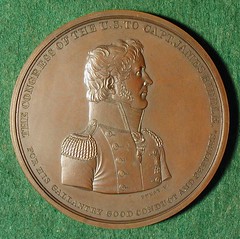
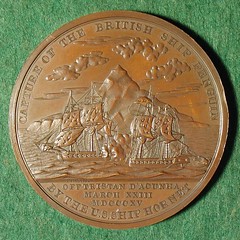
To read the complete article, see:
CAPTAIN JAMES BIDDLE
(www.historicalartmedals.com/MEDAL%20WEB%20ENTRIES/USA/
FURST/CAPTAIN%20JAMES%20BIDDLE-BW128%20HIGH.htm)
To read the earlier E-Sylum article, see: QUERY: U.S. MINT CAPT. BIDDLE MEDAL (coinbooks.org/esylum_v14n28a11.html)
QUERY: INGLE SYSTEM SCRIP LEDGERS AND VIRGINIA TOKEN BOOKS
I was recently introduced to The E-Sylum from my long-time numismatic mentor, Gene Brandenburg, and I have spent many hours reading back issues. I have to say that I am kicking myself for not subscribing earlier as this is one of the best sources for all things coin-related I have encountered. It is a joy to read and I thank you for making The E-Sylum available.
If you permit my indulgence from a brand new subscriber, I have two queries I would like to send your way that have crossed my path in the course of my research on Virginia numismatics and exonumia that perhaps either yourself or someone on the list would be able to answer.
The first concerns the ledgers and account books for the Ingle System scrip makers. I have recently completed a checklist on Ingle System scrip from Virginia and have used only secondary sources to complie it. I have seen the photos of two pages from the ledgers in Stuart Brown's excellent book, Scrip: Trade Tokens Issued by United States Coal Mining Companies & Company Stores, and I also consult Richard's Token Database, Tony Chibbaro's mavericks database, in addition to Wagaman's 1987 book on them. All these sources make direct reference to the ledgers but I have not seen where the original ledgers themselves are available. I hear them variously referred to as the account books, the shipping books, and just plain old "ledgers" or "records".
So, does anyone know anything about the ledgers themselves, what do the Ingle records comprise, and where the Ingle ledgers are located? Have they been published in any capacity, and, if not, are there any plans to make them available to researchers? I would also love to know what time period they span - do they encompass both Ingle System and Ingle-Schierloh? As you can tell, I am most curious about these ledgers and would like to ensure the accuracy of my checklist.
The second query is about a line in the latest VNA Newsletter that mentions a forthcoming update to the Virginia Tokens book. Does anyone know who is heading that project up? I know I have several trade tokens and related material that may be of interest to the authors that I have uncovered during my research into the local paper money and tokens from the Northern Blue Ridge and would be more than happy to share what I have found should they require.
Dave Schenkman writes:
The Virginia Numismatic Association has asked me to do a new catalog of Virginia tokens. Iâve been compiling descriptions of tokens not listed in the first edition ever since I completed it. My original Virginia book, which was published by VNA in 1980, listed about 2,500 tokens. I anticipate that the new book will have twice that number of listings.
NOTES FROM E-SYLUM READERS: JULY 17, 2011
Philatelic West Magazine
Len Augsburger writes:
Dave Perkins' note about Bolender's advertisements reminded me that there is a full run of Philatelic West in the Nebraska Historical Society in Lincoln, NE (where it was published). As far as I know it has not been numismatically searched. If there are any NBSers in the area it would be great to have a report. The run is significant - from 1895 to 1931, if memory serves. The ANS has a few loose issues which are crumbling. I made quite a mess of it when I called for them a few years ago.
To read the earlier E-Sylum article, see: M. H. BOLENDER'S COIN CHATTER (coinbooks.org/esylum_v14n28a06.html)
Robert Lecce
Pete Smith writes:
Coin Dealer Robert Lecce of Boca Raton, Florida, died of cancer on Sunday, July 10. He requested there be no funeral but a small memorial service was held on Saturday with several dealers in attendance. Lecce was in business with his son Richard. They specialize in rare date U. S. gold coins and modern commemorative gold.
A memorial fund has been established at the ANA for the YN program. As of Saturday, more than $100,000 had already been pledged.
On U.S. Paper Money Redesign
Regarding Peter Gaspar's comment in the previous issue, Joe Boling writes:
The dollar bill is not "the only American banknote that has not been redesigned." I use $2 bills all the time, and they have also not been changed (the 1976 revamping of the back does not fall in the same class of change as has been executed on the other denominations).
Mark Tomasko agrees. He writes:
I was surprised by the comments of one of your correspondents on the dollar coin vs. bill. He admits that "Certainly if you ask the public they will say they want to continue using dollar bills." So why shouldn't the public's wishes be respected? Convenience is the issue, and the public's strong preference is my guess as to why the dollar bill is not being withdrawn. I don't think the American public would put up with the nanny-state nonsense as easily as the Europeans and Canadians did, and the politicians know it. Probably equally significant is the fact that the dollar bill now circulates for 40 months, up from 18 months two decades ago, a very significant increase, making the savings even more illusory.
The writer also says that it is obvious that it is the Treasury's intention to discontinue the dollar bill, asking "Why else is the dollar bill the only American bank note that has not been redesigned?" The two hasn't been redesigned either, but I suspect the reason the one has not been redesigned is that it is rarely counterfeited. Therefore there was no reason to redesign it. The redesign of the other notes was because of counterfeiting, and involved expensive innovations. On the coin side, however, there is, as most people know, a serious counterfeiting problem with the pound coin.
To read the earlier E-Sylum article, see: THE PAPER DOLLAR VS COIN DEBATE (coinbooks.org/esylum_v14n28a15.html)
Chris Young fan Club 'Coins'
An E-Sylum reader writes:
In the vein of military challenge coins, country singer Chris Young issued 500 "coins" for the attendees of his fan club's 10th anniversary party.
Canadian-American Parking Meters
Dick Hanscom writes:
Dick Johnson's "a penny for your thoughts" brought to mind this story that I remember from a libertarian magazine in the late 70s. I am writing from memory.
A man in Canada had accumulated a vast number of parking tickets. The police finally arrested him. He was taken before a judge to plead his case.
"Your honor" or whatever they call judges in Canada, he said, "the parking meters are asking me to pay for parking with foreign coins. They are asking for nickels, dimes and quarters. Canada does not have nickels, dimes and quarters. We have 5 cent coins, 10 cent coins and 25 cent coins."
Apparently, the meters were made in the US.
Case dismissed. All the parking meters in Canada had to be changed.
I have been repeating this story in the shop for years, claiming this guy is my favorite anarchist.
It would be interesting to know if this story is true, or urban legend!
On Dec. 14, 1966, a green Jaguar belonging to Queen's University law student (now lawyer) Matthew C. Hudson was given a parking ticket by a Kingston, Ont., meter maid. He had received so many tickets he decided to fight one as a matter of principle.
When the case got to trial, the magistrate acquitted Hudson of the charge. The court ruled the city's parking meters bore invalid instructions because they referred to pennies, nickels, dimes and quarters. The court ruled that there were no such Canadian coins. Unfortunately, the city of Kingston appealed, and the outcome was closely watched by other municipalities which also had similar inscriptions on their parking meters. Hudson's argument before Justice C. D. Stewart of the Supreme Court of Ontario took more than 40 minutes.
He argued that Kingston's parking meter bylaw prohibited the use of substitutes for coins it defined as one-, 5-, 10- and 25-cent pieces. He noted that the Currency Act did not mention pennies, nickels, dimes and quarters, and conflicted with the Criminal Code, which required that only coins designated on meters could be used. The judge, who was obviously amused, questioned Hudson at length on the legal points he was making, and complimented him on an ingenious argument, but said he could not agree with him. The case was sent back to the magistrate and Hudson eventually had to pay the parking ticket. Although a transcript has not survived, the court presumably made its ruling on the basis that the wording on the parking meters was colloquial, and the intention was quite clear.
And that is why, even to this day, coin accepting devices across the country - including those on parking meters and, yes, newspaper boxes - still refer to our coins by the names or nicknames of their American counterparts.
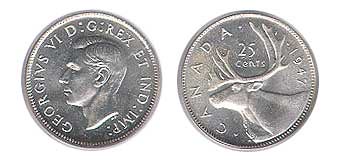
This is NOT a Quarter...
To read the complete article, see:
Coins
(www.canadiancoin.com/coin_articles.asp?name=documents/
archive/arron_coins_oct_30.txt)
To read the earlier E-Sylum article, see: DICK JOHNSON: A PENNY FOR YOUR THOUGHTS (coinbooks.org/esylum_v14n28a14.html)
WAYNE'S NUMISMATIC DIARY: JULY 17, 2011
This week brought another meeting of my Northern Virginia numismatic social group, Nummis Nova. Mike Packard was our host, and we gathered at Esposito's, an Italian restaurant in Fairfax, VA. I arrived about 6:30 and our table was nearly full. Already there were Jon Radel, Tom Kays, Rich Licato, Ron Abler, Gene Brandenburg, Dave Schenkman, Joe Levine, Chris Neuzil, and Mike Packard. Wayne Herndon arrived shortly after I did.
The date was Tuesday, July 12th. With Bastille Day on the 14th Mike suggested a theme of French coins and medals. We had some great exhibits. One of the first items passed around was a copper 1781 Libertas Americana medal, one of perhaps 300 made, and a nice condition example at that. It was Dave Schenkman's, and he provided the following images. Thanks - great medal!
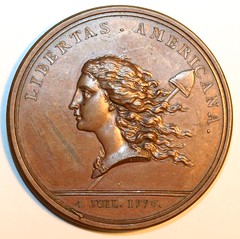
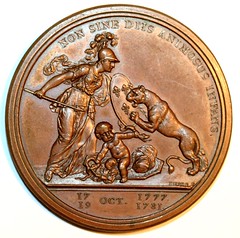
Other items included a neat shield-shaped, brass box containing a set of seven identical, 18th century C.W.B. & Co., Birmingham Gaming Tokens in the style of George III, Spade Guineas of 1790. The tokens were purchased together with the box in England and could well have been contemporary to each other. Also passed around was a framed display of French coins and tokens in use before the Bastille was liberated, many of which also could have circulated in the American colonies. Nice stuff.
Also on hand were some nice counterstamped and chopmarked coins brought in by Rich Licato. More later - see the next article in this issue for details.
Gene brought in a book for me to see. I'm not familiar with it, but perhaps an E-Sylum reader can help. Below are some images. It appears to be a collection of plates illustrating coins and medals of Britain and Scotland. It's in a 3/4 leather binding labeled "Book of Coins" on the spine. There is no text.
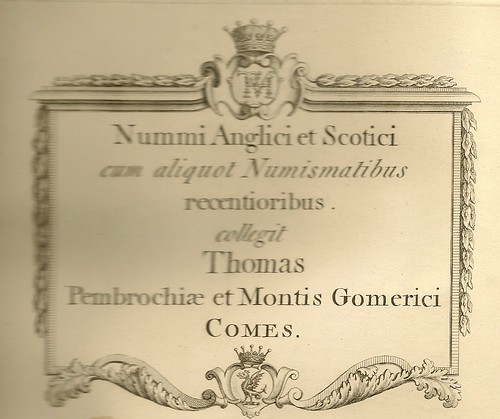
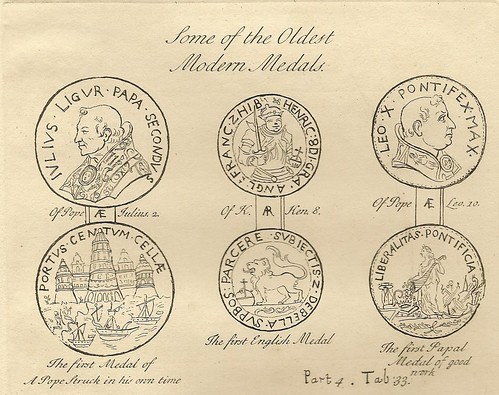
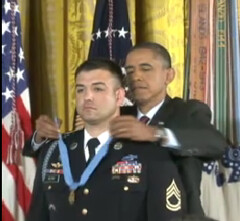 Another topic of discussion was the Medal of Honor, sometimes called the "Congressional Medal of Honor" and its confusion with the Congressional Gold Medal.
Another topic of discussion was the Medal of Honor, sometimes called the "Congressional Medal of Honor" and its confusion with the Congressional Gold Medal.
This prompted recollection of my part in acquiring Gen. Matthew Ridgeway's Congressional Gold Medal at a Pittsburgh estate auction on behalf of John J. Ford, Jr. The Medal of Honor is covered by the Stolen Valor Act and is illegal to sell.
The U.S. Congressional Gold Medals are not so encumbered, and Ford's Ridgeway medal was sold publicly in the Stack's sales of his collection.
Later in the week I found online a video of President Obama presenting a Medal of Honor to US Army Sergeant First Class Leroy Petry. For more information see: Medal of Honor awarded to Sergeant First Class Leroy Petry (www.longwarjournal.org/videos/2011/07/medal_of_honor_awarded_to_serg.php)
I also spoke to Jon Radel and Wayne Herndon about the kids program at the upcoming Annandale, VA coin show - next weekend, Saturday, July 23rd. I'm way behind on planning for this - we may have to wing it!
We broke up about 9 o'clock. These gatherings are a lot of fun, but also very educational. I've learned a great deal about many unusual areas of numismatics (without hardly trying)!
COUNTERSTAMP RESEARCH: THE HALLMARKS OF THEOPHILUS BRADBURY
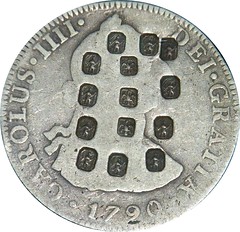
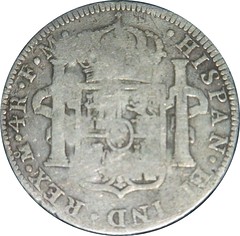
Rich Licato hosts a website for coins with Oriental chops in which he specializes. He brought an unusual coin to dinner with unknown counterstamps. A 1790 Mexican four reales, held three identical eagle stamps and eleven identical Native Americans stamps in array on the obverse. Sitting opposite Rich, Mike Packard immediately recognized the significance of the two symbols together as those used on Massachusetts coppers of 1787 and 1788. Each punch was small and raised within an octagon shape, like a rectangle with the corners clipped.

After thinking a bit Mike suggested that silversmiths might use such punches. Mike then mumbled âTheophilus Bradbury.â We blessed him, and he said, that was no sneeze but the name of a Massachusetts silversmith he had come across in his study of Jacob Perkins, of Newburyport, Massachusetts, maker of steel printing plates for printing currency and engraver of the famous Washington Funeral Medals (Skull and Cross Bones as well as Urn motifs) used in Boston in 1800.
A side conversation with Gene Brandenburg who was learning to use his new Android phone led us to consult the Internet on the spot. We found an image of his silver marks on a set of spoons. Theophilus Bradbury used an eagle punch, the letter âBâ and a Native American punch said to be a mirror image of the Massachusetts symbols. The eagle punch with head right, is so distinctive we had a positive ID right there at dinner with but five minutes research.
Theophilus Bradbury, (1763 â" 1848) silversmith of Newburyport, partnered with Joseph Moulton (1744-1816), another eminent silversmith. Their shop âMoulton & Bradburyâ was on Merrimack Street in Newburyport by 1796 where they made plated buckles. By 1815 Theophilus was in league with his son, Ebenezer as âTheophilus Bradbury & Sonâ making soup, sauce and cream ladles, table and tea spoons, sugar basins, tea pots, cream pots and pitchers. Jacob Perkins is said to have inspected Theophilus Bradbury & Son spoons in 1816 finding them equal to European manufacture.
May we surmise Theophilus needed to test a new set of punches, perhaps to find the right amount of hammer pressure to raise a good image but not enough to damage a fine silver spoon? Taking a silver coin at hand he idly whacked it over a dozen times until satisfied, and then applied the punches to finish his product. Rich was thrilled to have such eminent provenance applied to his coin.

To visit the CyberAttic site, see: Set of 6 tsps by Theophilus Bradbury, Newburyport, Mass (www.cyberattic.com/stores/NorthHill/items/898096/en2cyberattic.html)
I should note that the Native American punch is NOT that same as the one on Mike Packard's enigmatic coin illustrated earlier in The E-Sylum. That stamp is much larger, matches the Massachusetts symbol without mirror-imaging, and still unattributed. -Editor
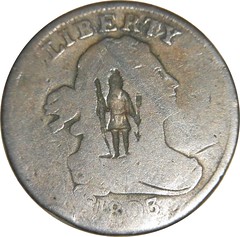
To read the earlier E-Sylum article, see: AN ENIGMATIC NATIVE AMERICAN COUNTERSTAMP (www.coinbooks.org/esylum_v14n26a16.html)
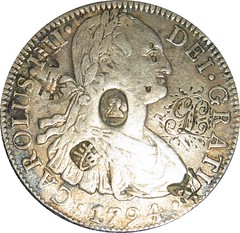
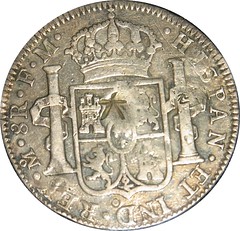
As an exercise for E-Sylum readers who unfortunately did not dine with us, we invite you to supply provenance for another of Richâs interesting chopped coins pictured above, a 1794 Mexican eight reales. Notice the King George III counterstamp at center, the engraved script initials âGLâ with flourishes at 3:00 oâclock (a love token?), the unusual and exotic large punches, small, Type I chops, and blundered or damaged letters in the legend (see âREXâ on the reverse for example). Starting at face value in Mexico City in 1794, or perhaps starting elsewhere if you believe this to be a counterfeit (e.g. Birmingham plate, New York forgery, 19th century Boston reproduction?), what is this coinâs story? Begin sleuthing.
OSTHEIMER COLLECTION RARITIES SALE PART III
At the 2011 Chicago ANA Convention Jeff Shevlin will be holding the third in a series of sealed bid sale offering rare So-Called Dollars from the famous Ostheimer Collection. As noted in The E-Sylum Volume 13, Number 31, August 2010, âthe Ostheimers were contributors to the first edition of the Hibler &Kappen book So-Called Dollars. They corresponded heavily with Hibler in the early 1960s, prior to the first edition of the H&K book being published.
Over 70 of the plate photos in the first edition of the H&K book are from the Ostheimer Collection. Many of these specimens are extremely rare, with some H&K numbers not having been seen in over 50 years! The majority of the SCDs were stored in old Kraft 2X2 envelopes, wrapped in jeweler's tissue and unopened since the 1960s. Some were in their original holders. Eighty-nine specimens from the Ostheimer Collection are plated in the second edition of the H&K book.â
The first sealed bid sale was held at the 2010 Boston ANA and set many record prices, as did the second sale held at the FUN Show in January 2011. Lots from these two sales are archived on Jeff Shevlinâs website, along with color photos of each specimen and the prices realized. To view the archives, click on the following link: http://so-calleddollar.com/DollarSite/DollarPhotos.aspx?category=220&title=Auction Archives .
The third Ostheimer sale will include 80 Specimens from the Ostheimer Collection along with selected rarities from the Jeff Shevlin Collection. Sale #3 is particularly rich in plate coins from both the first and second editions of the H&K So-Called Dollar book, with a fair number of the medals having come from the personal reference collection of Harold Hiblerâs. There are numerous condition rarities, including a number of extremely rare specimens that are the only examples of the die marriages graded by NGC.
Photos and lot descriptions for Shevlinâs Chicago ANA sealed bid sale can now be viewed on Shevlinâs website by clicking on the following link: http://so-calleddollar.com/DollarSite/ForSaleDollars.aspx?category=220&title=Auctions .
NBS members and E-Sylum readers are also invited to stop by and view these historical and rare medals in person at Jeffâs table at the 2011 Chicago ANA Convention in August.
Lots will also be available for viewing at Jeffâs table at the ANA Convention all week and up until bidding closes at 5:00PM EST Friday, August 19, 2011. Bids may be placed at the ANA Convention, buy telephone, e-mail or mail. Terms of the sale and a bid sheet are now posted on Jeffâs website at so-calleddollar.com
To read the earlier E-Sylum article, see: OSTHEIMER COLLECTION RARITIES OFFERED (coinbooks.org/esylum_v13n31a18.html)
COMBINE COINS AND THE GREAT OUTDOORS!
"TIME CAPSULE" SNELL COLLECTION OF CHINESE COINS OFFERED
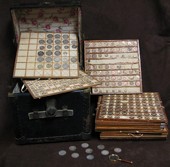 A vast collection of Chinese coins assembled by Dr. John Abner Snell and housed in a steamer trunk will be auctioned by Steven L. Davis of Numismatic Auctions LLC later this year, according to the firm.
A vast collection of Chinese coins assembled by Dr. John Abner Snell and housed in a steamer trunk will be auctioned by Steven L. Davis of Numismatic Auctions LLC later this year, according to the firm.
The collection consists of an array of mostly 20th century Chinese coins, each meticulously tied with silk twine into 15 custom-made, fabric-lined trays that fit into a 60-pound steamer trunk. The historic collection represents a time capsule of Chinese numismatics from Empire to Republic issues, augmented by an extensive offering of Provincial issues in copper, brass and silver.
Among the highlights are a brass Chekiang Province 10 cash double dragon mule, a copper 10 cash Tai-Ching-Ti-Kuo double dragon mule, a 1921 silver Hsu Shih Chang plain edge pattern pavillion dollar, a 1904 silver Hupeh Province tael, a 1906 brass Kiangsu Province 2 cash pattern, a 1916 Yuan Shih Kai Hung Hsien silver dragon medal and a 1914 Yuan Shi Kai Republican silver dollar.
The collection returned from China with Snellâs widow, Grace Snell, in 1936. The coins were given to their oldest son, John Raymond Snell, probably sometime in the early 1940s. When he died in April 2003, the collection passed to his wife, Florence Moffett Snell, who died in November 2007. Her will designated that her estate be distributed equally among the coupleâs five children. The five siblings have agreed to offer the collection at auction so that the coins will end up in the hands of the numismatic public.
Complimentary catalogs and more information on the sale can be obtained by contacting Numismatic Auctions online at www.numismaticauctionsllc.com, by writing P.O. Box 22026, Lansing, MI 48909, calling (517) 394-4443 or by faxing (517) 394-0579.
Biographical and historical information compiled by Dale Dailey.
To read the complete article, see: Snell's Chinese Coins to Be Sold (www.numismaster.com/ta/numis/Article.jsp?ad=article&ArticleId=21959)
NEW PARIS MINT COMMEMORATIVE COINS SIMULATE HAMMERED STRIKING
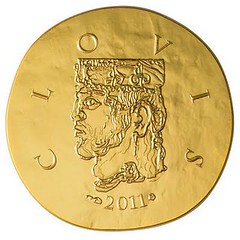
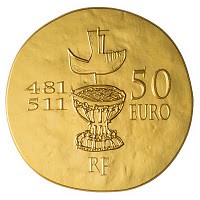
Long before the invention of electricity, before steam powered everything, and even before the perfection in the forging of iron and steel to make manual machines, coins were hammered by strong men in order to impress the image on the coinage metals.
Hammered coins were rarely perfectly round. Aside from there being no collar surrounding the blank to keep it in place, Depending on the strength and skill of the coiner, the image may not transfer perfectly, the thickness may vary, the coin could exhibit flat edges, and striking errors. Collectors of these coins, mostly pre-17th century, find beauty in the character of each strike.
Monnaie de Paris (The Paris Mint) announced that it will create coins with the theme âFrom Clovis to the Republicâ commemorating 1500 years of the history of France. The theme and design concepts were created by famed designer Christian Lacroix, Artistic Advisor of the Monnaie de Paris. The series will celebrate 15 kings, emperors, and presidents over five years that represents French history from Clovis I through Fraçois Metterand.
To give the coins a similar character to what might have existed during the time of Clovis and Charlemagne, Monnaie de Paris developed a method to make the coin appear to be hammer struck using modern minting equipment. The obverse of both coins has a portrait as it might have appeared at the time.
I like the idea to make commemoratives honoring historic figures designed and struck to look close to period pieces. It will be interesting to see how the people who vote for Coin of the Year reacts to these coins.
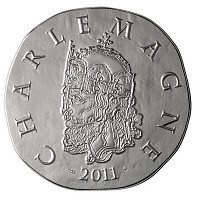
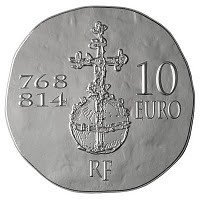
To read the complete blog post, see: Hammered Commemoratives (coinsblog.blogspot.com/2011/07/hammered-commemoratives.html)
THE MAN WHO LOVED PRESIDENTIAL MEMORABILIA TOO MUCH?
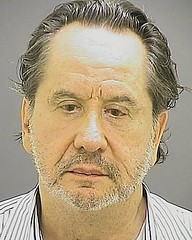 A published presidential historian was one of two men caught with millions of dollars in documents from the Maryland Historical Society, including some signed by President Abraham Lincoln, according to court documents.
A published presidential historian was one of two men caught with millions of dollars in documents from the Maryland Historical Society, including some signed by President Abraham Lincoln, according to court documents.
Baltimore police charged Barry Landau, 63, and Jason Savedoff, 24, both of New York City, on Saturday with theft of more than $100,000 and they were ordered held on Monday. The FBI is involved in the investigation under a federal statute that covers thefts from museums.
An employee told police he had been watching Savedoff and Landau for several hours, believing their behavior to be suspicious. He called police after he saw Savedoff conceal a document in a portfolio and walk it out of the library, according to court documents.
A search of a locker at the building that Savedoff was carrying a key to turned up 60 documents. That included papers signed by Lincoln worth $300,000, numerous presidential inaugural ball invitations and programs worth $500,000, a signed Statue of Liberty commemoration valued at $100,000 and a signed Washington monument commemoration valued at $100,000, court documents state.
To read the complete article, see: New York Men Charged in Maryland Historical Society Presidential Artifacts Theft (www.artdaily.org/index.asp?int_sec=2&int_new=48988)
To read the complete article, see: Presidential Historian and Colleague Arrested in Theft of Documents in Maryland (www.nytimes.com/2011/07/13/us/13historian.html)
Federal authorities searched the Manhattan apartment Wednesday of a collector and author charged with stealing documents from the Maryland Historical Society, according to a source familiar with the investigation.
Barry H. Landau, 63, and another man continue to sit in the Baltimore City Detention Center, held on no bond. Landau's attorney formally filed a petition for a bail hearing in Baltimore Circuit Court and is awaiting a date.
Landau and 24-year-old Jason Savedoff were arrested Saturday at the Maryland Historical Society after police say the pair tried to steal documents, including one signed by Abraham Lincoln. Baltimore police charged each with one count of theft over $100,000.
Landau, who lives two blocks south of New York's Central Park on West 57th Street, is said to have the largest private collection of presidential inaugural memorabilia outside of museums of the presidential archives. He was a former White House protocol officer and has connections to New York, Washington and the Hollywood elite.
Earlier this week, the FBI alerted museums, small libraries and historical societies throughout the region to check whether the pair might have committed similar thefts. On Tuesday, the Historical Society of Pennsylvania confirmed that Landau and Savedoff, who used an alias, had visited more than a dozen times and aroused suspicions with "odd" behavior.
Lee Arnold, senior director of the library and collections at the Historical Society of Pennsylvania, said that he and his staff were reviewing numerous "call slips" filled out by Landau and Savedoff during more than a dozen visits to the Philadelphia institution since December.
"We keep those slips forever, and we're looking at those dates to see if anything is amiss," he said.
To read the complete article, see:
FBI searches N.Y. home of jailed memorabilia collector
(www.baltimoresun.com/news/maryland/baltimore-city
/bs-md-ci-landau-raid-20110713,0,6692669.story)
TURNING DOLLAR COINS INTO FREE TRAVEL
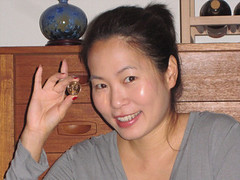 We recently reported on the the government's failed effort to persuade Americans to use dollar coins.
We recently reported on the the government's failed effort to persuade Americans to use dollar coins.
But the coins have found at least one group of fans: Travel enthusiasts who buy thousands of dollar coins with credit cards that award frequent-flier miles for purchases.
Once in possession of the coins â" shipped to them by the government for free â" they can deposit them into their bank accounts and pay off the credit card bills. The result: a free ticket to anywhere.
"We've used them to go on trips around the world," says Jane Liaw, a 35-year-old public health researcher and science writer in San Francisco. Liaw says she and her husband, who use a variety of tricks for earning miles, are planning trips to Greece and Turkey, "all on miles and points."
Liaw says she spends some of the coins at the local farmer's market and stores.
The problem is that even if so-called "travel hackers" like Liaw put some of the coins in circulation, their purchases from the Mint contribute to a huge and growing buildup of one-dollar coins in Federal Reserve vaults.
The mountain of coins is the unintended result of a 2005 act of Congress. The law requires that more and more coins be minted, despite a lack of demand by the public.
As long as the dollar coin scheme is viable â" without a crackdown by credit card issuers, for example â" there will be enthusiasts like Ben Schlappig, who writes the travel hacker blog One Mile At A Time.
"I'm not as heavy a hitter as other people, I guess," Schlappig says. "I've ordered probably, maybe 30 or 40,000 worth."
Schlappig, who says he has "a few million miles" and top-tier status with several airlines, orders at the Mint's limit.
"Just last week I came back from a trip from Australia and Singapore and Malaysia all in first class, just on miles," he says, "partly thanks to the dollar coin program."
To read the complete article, see:
How Frequent Fliers Exploit A Government Program To Get Free Trips
(www.npr.org/blogs/money/2011/07/13/137795995/how-frequent-fliers
-exploit-a-government-program-to-get-free-trips)
CAPTAIN BLIGH'S MEDALS TO BE SOLD
TWO gold medals awarded to William Bligh of Mutiny on the Bounty fame are to be offered for sale at auction by his descendants this month. In what is one of the most significant offerings of maritime history in recent years, the medals together have been given an estimated catalogue price of $250,000 but could fetch significantly more.
The first medal was awarded in 1794 by the Royal Society for Bligh's work relating to breadfruit, which had been discovered in Tahiti.
The botanist Sir Joseph Banks wanted to transplant the crop to the West Indies as food for slaves.
he second medal, estimated to be worth $200,000, is slightly smaller and is the Naval Gold Medal 1795, awarded to ship captains.
Bligh won it for his role at the Battle of Camperdown, an important naval action on October 11, 1797, between the Royal Navy fleet and the Dutch navy, in which the British captured 11 Dutch ships without loss of any of their own.
The medals are included in the Noble Numismatics auction on July 26-28 at Melbourne's Dallas Brooks Centre.
To read the complete article, see: Bligh's medals tipped to fetch $250,000 (www.theage.com.au/national/blighs-medals-tipped-to-fetch-250000-20110709-1h7zs.html)
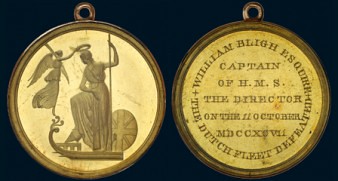
To read the complete article, see: Highlights of our important July auction (www.noble.com.au/auctions/article?id=26)
S. KOENIGSBERGER GOLD BAR SURFACES
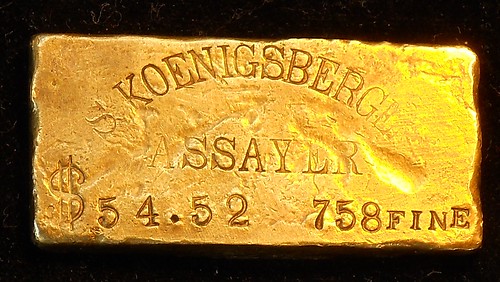
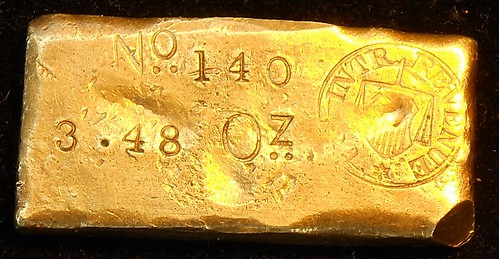
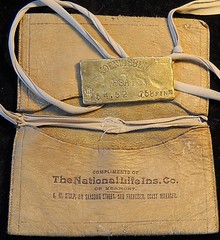 Recently, a gentleman posted images of a previously unknown gold bar that he had purchased from an estate auction and he was asking the members of the Collectorâs Universe website forum if the bar was indeed genuine. At first glance, I thought the bar was a modern fake meant to deceive the buyer as a genuine piece of history from the Wild West.
Recently, a gentleman posted images of a previously unknown gold bar that he had purchased from an estate auction and he was asking the members of the Collectorâs Universe website forum if the bar was indeed genuine. At first glance, I thought the bar was a modern fake meant to deceive the buyer as a genuine piece of history from the Wild West.
Since there have been so many fake gold bars that have come onto the numismatic market place over the years including those allegedly from F.G. Hoard and Star Mining, the bar has been raised (pun intended) when authenticating such pieces. However, after looking at the photos of the bar, I thought it had a chance of being the real deal, or at the very least it was a well made fake when compared to the previously mentioned bars. Thus I decided to take a closer look at the history of the alleged maker of this small gold bar.
The bar in question was stamped by an assayer previously unknown to me, S. Koenigsberger. It turns out that he was listed in the 1864 San Francisco Directory as being an assayer for the Goldsmith Brothers. Since the bar was stamped with his own hallmark, S. Koenigsberger assayer, it was probably poured after his employment with the Goldsmith Brothers.
The bar was also stamped with the Office of Internal Revenue circular tax stamp which provides another clue as to the time period of the barâs manufacture. This means if genuine, the bar was made circa the last half of 1864 to the Spring of 1868 when the tax act was repealed. Of course having a tax stamp on a bar does not mean the bar is genuine since there are known fakes bearing such a stamp.
In support of the barâs historic authenticity, Koenigsberger was listed in Langleyâs 1867 Pacific Coast Directory as S. Koenigsberger assayer Idaho City, Boise County Idaho Territory.
The local Idaho City press in May of 1867, stated that S. Koenigsberger had re-built his assaying and merchandise business at its old spot on Main Street after a fire had swept through the town. His advertisements noted that he assayed gold, silver and all kinds of mineral-ores and also gold dust that was made into ingots or bars.
Thus if this bar is genuine there is a good likelihood it was produced from gold found in the Idaho Territory or perhaps the Montana Territory circa 1866-1868. Sebastian Koenigsberger went on to spend decades in the Black Hills at Deadwood, South Dakota Territory, where he was a merchant, assessor, and / or involved in gold mining. He often traveled to Europe with his wife. He was born in Germany and I believe he passed away in South Dakota in July of 1923.
In closing, I donât know whether or not this bar is a genuine piece of Western Americana. It may in fact very well be. I am sure that well known ingotologist Fred Holabird, will have more to say about this bar, at the August 20th meeting of the S.P.P.N at the ANA Worldâs Fair of Money. Author Karl Moulton will also be speaking at the meeting in part about assay bars from his upcoming book on the Franklin Hoard.
I will note that finding related evidence in archives doesn't prove anything. Master Mormon document counterfeiter Mark Hoffman often researched in the Mormon archives for references to the possible existence of certain documents, then manufactured corresponding specimens, When others researched the items, lo and behold - there was archival evidence to support their existence. Genuine Koenigsberger ingots may well exist somewhere, but is this one of them? It will be interesting to hear the eventual determination, if one can be made. -Editor
THE BOOK BAZARRE
NUMISMATIC SIGNIFICANCE OF THE SREE PADMANABHASWAMY TEMPLE TREASURE
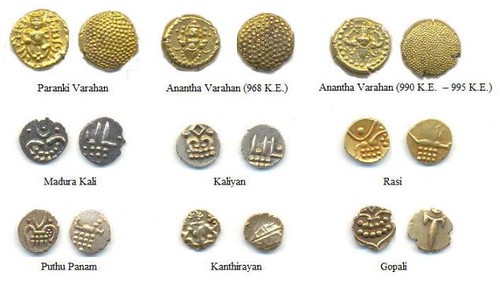
The antiquity of the priceless jewels and valuables found in the vaults of the Sree Padmanabhaswamy temple in Thiruvananthapuram in recent weeks can be assessed with the aid of the Mathilakam Records, and the stone inscriptions found on the eastern wall of the first prakara of the Kanyakumari temple. These records reveal that the precious articles are indeed offerings made to the temple over the centuries.
On the 5th of Makaram ME 925 (AD 1750), Marthanda Varma made over his whole kingdom to Perumal Sree Padmanabhaswamy and assumed its management as a vassal of the deity. He and his successors assumed the role and title of Sree Padmanabhadasa. History bears testimony to the fact that they lived up to this self-imposed role.
The coins struck immediately thereafter bore the device of the deity. One such copper coin was reportedly found in the Netherlands recently by a mine-detector pilot along with other material from the 18th and 19th centuries. Considering that Eustachius D'Lannoy, the Dutch commandant in the Battle of Colachel (AD 1741) who was captured by Marthanda Varma later, rose to become the commander-in-chief of the Travancore Army, it is not surprising that a coin depicting Sree Padmanabha found its way to the Netherlands.
During successive reigns, gold coins minted in Travancore were appropriately named Anantha Varahan and Anantha rayan panam. This was a departure from the then current Rasi and the Kaliyan panam, which owed their origin to neighbouring kingdoms. The silver double chuckram minted in AD 1810 bears the legend âPadmanabhan' in old Malayalam script. These coins are mentioned in the Mathilakom Records as coins found in the vanchika of the temple. Nagamaiya, in the Travancore State Manual, gives the Anantha Varahan the value Rs. 3-15-5 (or three rupees, 15 annas, five pice), but does not describe it.
Therefore, until recently there was no means to identify the Anantha Varahan that was minted in Padmanabhapuram and Alleppey. However, Barbara Mears stumbled upon a line drawing of this coin with an article (The Journal of the Asiatic Society of Bengal, Volume LII, Calcutta, 1883, Pages 35-55) by Major Bidie, who was the Superintendent of the Madras Museum: he had obtained two of the coins from the maharaja's treasury. This helped identify the Anantha Varahan (Studies in South Indian Coins, Volume XXI, Barbara Mears, Pages 81-86; Beena Sarasan, Pages 87-90).
More details of donations in the form of coins are available in the Mathilakom Records. For example, Volume 60, Page 102, shows that on ME 952-9-9, the following coins were found in the vanchika: Kaliyan, Old Kaliyan, Kozhikode Panam, Rasi, Madurakali, Kanthirayan Panam, Gopali Chakram, and so on. Volume 8, Page 175 gives the list of coins counted on ME 952-11-9. Again, on ME 976-6-27, Velu Thampy Dalava, along with Thrippapur Mootha Tiruvadi, offered 11 Paranki varahan (Churuna 128, Ola 218).
Thus, the treasures now found in the vaults are those offered to Sree Padmanabhaswamy and that accumulated over the centuries. The earliest recorded gift was that of Parantaka Pandya in AD 12th century.
To read the complete article, see: Tales that the fabulous collection in the vaults tell (www.thehindu.com/news/national/article2233694.ece)
OPERATION BERNHARD COUNTERFEIT NOTES RECOVERED FROM LAKE TOPLITZ TO BE SOLD
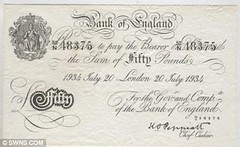 A rare set of fake bank notes Hitler had printed in a bid to ruin the British economy during World War Two are expected to fetch £2,000 at auction.
A rare set of fake bank notes Hitler had printed in a bid to ruin the British economy during World War Two are expected to fetch £2,000 at auction.
Hitler hoped the £134million of counterfeit notes he produced in 'Operation Bernhard' would force a huge hike in inflation and spark a cash crisis if introduced to wartime Britain.
He ordered millions of the notes, in £5, £10, £20 and £50 denominations to be printed in 1942. Four bank notes recovered from Lake Toplitz in Austria will be auctioned next month.
The £5, £10, £20 and £50 notes will go under the hammer at Mullock's auctioneers at Ludlow Racecourse, Shropshire on August 18. Nazi spies had been ordered to smuggle the cash into Britain and flood the economy with the fake money. But Hitler's plan was foiled when British spies got wind of the idea and intercepted the shipment of the notes.
At the war's end the mint notes still in Germany were dumped in Lake Toplitz together with the printing plates made to produce them after 'Operation Bernhard' was abandoned with just a handful of notes having made it into British circulation. But they were enough for the Bank of England to withdraw all banknotes of £5 and over from circulation after it had designed and printed a new set of paper money.
To read the complete article, see:
Counterf-Hitler: Examples from the £134million in dodgy bank notes Adolf hoped would ruin the British economy expected to fetch £2,000 at auction
(www.dailymail.co.uk/news/article-2014016/Adolf-Hitlers-fake-British
-bank-notes-expected-fetch-2k-auction.html)
URSULA KAMPMANN'S GREEK NUMISMATIC DIARY: EDESSA
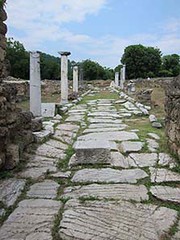 We immediately departed towards north because there were so many attractions to visit, like Macedon Edessa, ancient capital city of the Argeads.
We immediately departed towards north because there were so many attractions to visit, like Macedon Edessa, ancient capital city of the Argeads.
According to Herodotus, the name of this Greek city stemmed from the Phrygian word for water (= vedy). It is said that in antiquity Edessa was referred to as Garden of Midas.
Upon entering the excavation site of ancient Edessa, a young woman followed us. First we thought that we had taken the wrong entrance and had to pay fee, but no, entrance was free but we ought to take the flyer to appreciate the excavation properly.
And she reminded us to watch out for snakes. To enforce her point, the lady wore a stick like the one many Greeks lug around on archaeological excavations. The stick serves the purpose to keep the aggressive reptiles at an armâs length.
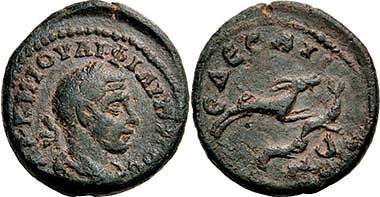
Edessa (Macedonia). Gordian III. Bronze. Av. Tranquillina. Rev. Roma l. sitting, city goddess of Edessa behind her, crowning her. From auction Numismatik Lanz 150 (2010), 375.
To read the complete article, see: Numismatic diary of a journey throughout Greece, part 4 (www.coinsweekly.com/en/News/4?&id=683)
QUERY: CARPATHIA CAPTAIN'S CONGRESSIONAL GOLD MEDAL INFORMATION SOUGHT
An E-Sylum reader writes:
On April 15 next year we have the centenary of the sinking of the Titanic. Captain Rostron of the Carpathia got a medal from Congress and the President for his efforts in rescuing survivors. There is a fabulous image of the plaster on the Library of Congress image website. I can find very little about the actual medal though: designer, how many struck, metal, size, etc etc. Maybe your readers can help out.
I found this reference to Rostron receiving the medal from the President, but it says nothing about the medal's design or designer.
President Taft presented to Capt. Arthur H. Rostron to-day the gold medal authorized by Congress for his courage and gallantry in rescuing the survivors of the Titanic and bringing them safely to New York on his own ship, the Carpathia.
The President made a brief speech, quoting the report of the Senate Investigating Committee to show the bravery, the painstaking care and the kindliness exhibited by Capt. Rostron. It was a record, he said, worthy of the best traditions of England's seafarers.
Capt. Rostron in reply thanked the President, Congress, and the American people. Ambassador Bryce thanked the President on behalf of the English people.
To read the complete article, see: CAPT. ROSTRON GETS MEDAL (www.encyclopedia-titanica.org/capt-rostron-gets-medal.html)
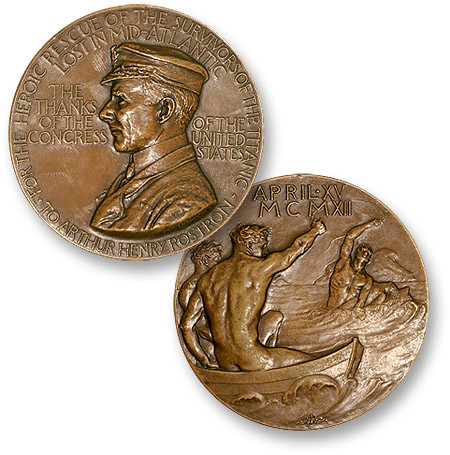
The medal was designed by American sculptor and medalist John Flanagan (1865-1952) who would later design both sides of the Washington U.S. quarter-dollar coin and more than four dozen items for Medallic Art Company over a forty-year period.
The dies for the Rostron medal were cut by Medallic Art Company, and the gold medal itself was struck by the United States Mint. The bronze sample shown here is from the archive of Medallic Art Company.
To read the complete article, see: Arthur Henry Rostron Medal (www.medallic.com/galleries/historic_gallery.php#history)
ARTICLE ON COINS IN KENYA
Dick Johnson writes:
Here's an Interesting long article on coins in Kenya. Lots of coin lore is discussed, like having holes in coins because natives had no pockets.
But have you ever wondered where local currency got its name?
Ours is called pesa, from Peso the Spanish currency. Our lowest denomination is five cents, also called Ndururu. Or Oruro in street slang. Ndururu is Swahili for "light, small, thin, undersize or weak." The 10-cent coin, or peni, had a Sheng name, Ng'och, which gradually diminished in use as the value of the shilling nosed south over the years.
The earliest currency in Kenya, according to the CBK was the Maria Theresa Thalers which were silver coins used in world trade since they were first minted in 1751. They were named after Empress Maria Theresa of the Austro-Hungarian Empire between 1740 and 1780.
The Maria Theresa Thalers found their way to shores of eastern Africa in the 1800s and were similar to the Spanish Peso hence the word pesa.
The coins hardly reached the interior despite their popularity at the coast. The Indian Rupees, however, managed to do so since it was used to pay the Asian labourers during the construction of the Uganda Railway.
To read the complete article, see: Kenya: No Coins Please, My Pockets Are More Precious (allafrica.com/stories/201107110172.html)
A BIBLIOPHILE'S NIGHTMARE: BAGHDAD'S JEWISH ARCHIVE
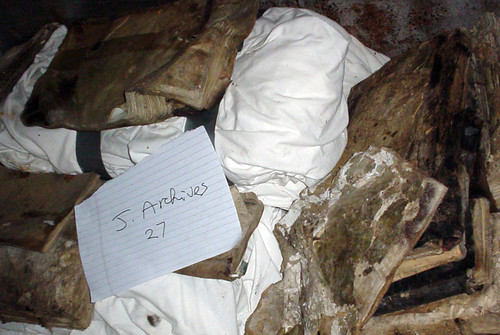
A trove of Jewish books and other materials, rescued from a sewage-filled Baghdad basement during the 2003 invasion, is now caught up in a tug-of-war between the U.S. and Iraq.
Ranging from a medieval religious book to children's Hebrew primers, from photos to Torah cases, the collection is testimony to a once vibrant Jewish community in Baghdad. Their present-day context is the relationship, fraught with distrust, between postwar Iraq and its Jewish diaspora.
Discovered in a basement used by Saddam Hussein's secret police, the collection was sent to the U.S. for safekeeping and restoration, and sat at the National Archives and Records Administration (NARA) in Maryland until last year, when Iraqi officials started a campaign to get it back.
Initially contacts went well, but now the deputy culture minister, Taher Naser al-Hmood, says "The Americans are not serious" about setting a deadline for getting back the archive.
U.S. officials deny that they are delaying its return. They say they only recently got the roughly $3 million needed to clean up the materials â" the whole point of bringing them to the U.S. â" and they question the rush to return the collection now, when the goal is so close.
"It is not U.S. government material, and we have every intention of returning it," said Phil Frayne, a spokesman for the State Department's Bureau of Near Eastern Affairs.
"We understand the frustration over the delay but we're happy that this is going to finally move forward," he said.
To read the complete article, see: Tug-of-War Over Iraqi Jewish Trove of Books and Other Materials in United States Hands (www.artdaily.org/index.asp?int_sec=2&int_new=48979)
A NEW JERSEY DINER'S LUCKY DOLLARS
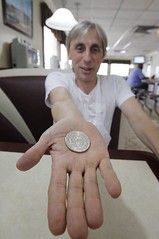 Amid the clink of glass and the clatter of plates, a faint jingle rises as Peterpank Diner owner Alex Panko shows the silver dollars, the coin of his realm, he bestows on a select few patrons.
Amid the clink of glass and the clatter of plates, a faint jingle rises as Peterpank Diner owner Alex Panko shows the silver dollars, the coin of his realm, he bestows on a select few patrons.
The Morgan silver dollars, named for designer George T. Morgan, pass from Pankoâs hand to the palms of those he has a special feeling about â" a small clientele at his Sayreville diner who are in dire straits or perhaps headed straight to the top.
Call it a side order of luck: Pankoâs coins have lined the finely tailored pockets of Gov. Chris Christie and the utilitarian uniforms of a U.S. soldier. Close friends have carried them, as has former congressional candidate Anna Little, who lost her race but nonetheless considers herself more fortunate for having the silver buck in her possession.
Now Panko, who says he doesnât distribute coins along party lines, is readying himself for this election season. He doesnât expect a big crowd of candidates at the Peterpank, but heâs prepared to vet them before he dishes out a lucky token.
"I canât just hand it to anybody because chances are theyâll win," Panko said. "Iâll pull them aside, talk to them, and if they sound like theyâre doing the right thing, working for the people, then Iâll slip them a coin."
"Iâve probably given out about 10 or 12 in my life," he said of the dollars he otherwise keeps in a safe-deposit box at his bank. "I do it as a good luck gesture for folks headed into danger or rough times."
The most notable hand-off occurred on Nov. 3, 2009.
Christie, the Republican candidate hoping to win the governorâs seat, stopped by the 54-year-old diner for some last-minute campaigning on Election Day. He said Panko called him into the kitchen and pulled a Morgan from his pocket.
"He tells me the story about his lucky coins and he says to me, âKeep it with you today and youâre gonna win, youâre gonna be governor,â " Christie recalled.
Whatever role the coin played, Christie won the election. At his inaugural ball two months later, Old Bridge Councilwoman Mary Sohor â" who works at the diner and in part credits her coin for her political success â" shouted above the cheering crowd.
"Congratulations from Alex," she told the newly minted governor.
Christie stopped, locked eyes with Sohor and pulled the coin from his pocket.
"We couldnât believe it," Sohor said. "He had kept it on him."
If they only knew â" the silver dollar never leaves his left pocket.
"Iâve never been superstitious in my life," Christie said. "Iâve never been one of these guys who worries about walking under ladders, broken mirrors or black cats. But I have carried Alexâs coin with me since Election Day."
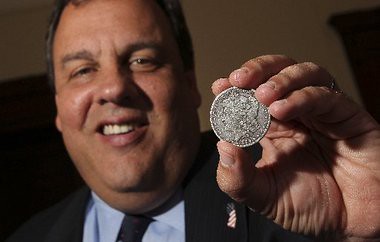
Gov. Christie with his lucky dollar
To read the complete article, see: Sayreville diner owner's lucky coins keep soldiers safe, politicians prosperous (www.nj.com/news/index.ssf/2011/07/sayreville_diner_owners_lucky.html)
FEATURED WEB SITE: THE CANADIAN NUMISMATIC PUBLISHING INSTITUTE
This week's Featured Web Site is Patrick Glassford's Canadian Numismatic Publishing Institute site, coinscan.com.Coinscan.com is a division of the Canadian Numismatic Publishing Institute, established in 1958 by Somer James, publisher of many fine Canadian numismatic publications such as âA GUIDE BOOK OF CANADIAN COINS, CURRENCY & TOKENSâ and âCANADIAN SILVER DOLLARS" by Starr Gilmore.

The site includes sections on
- Canadian Error Coins
- Canadian Minting Variety Directory
- Foreign Coins Struck by the Royal Canadian Mint
- The Millennium P - D - S Project
- Design in Canadian Coins
- Technical Aspects of Canadian Coinage
- Canadian Silver Dollars
www.coinscan.com

